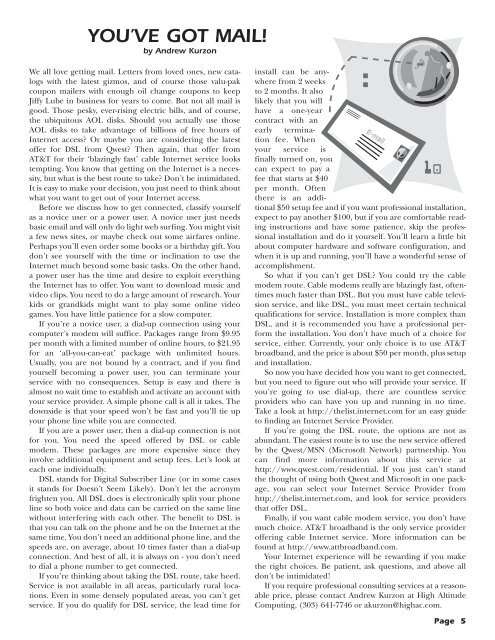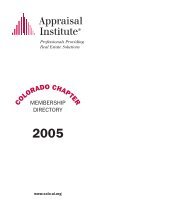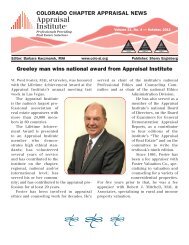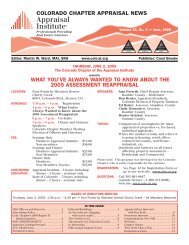colorado chapter appraisal news - Colorado Appraisal Institute
colorado chapter appraisal news - Colorado Appraisal Institute
colorado chapter appraisal news - Colorado Appraisal Institute
You also want an ePaper? Increase the reach of your titles
YUMPU automatically turns print PDFs into web optimized ePapers that Google loves.
YOU’VE GOT MAIL!by Andrew KurzonWe all love getting mail. Letters from loved ones, new catalogswith the latest gizmos, and of course those valu-pakcoupon mailers with enough oil change coupons to keepJiffy Lube in business for years to come. But not all mail isgood. Those pesky, ever-rising electric bills, and of course,the ubiquitous AOL disks. Should you actually use thoseAOL disks to take advantage of billions of free hours ofInternet access? Or maybe you are considering the latestoffer for DSL from Qwest? Then again, that offer fromAT&T for their ‘blazingly fast’ cable Internet service lookstempting. You know that getting on the Internet is a necessity,but what is the best route to take? Don’t be intimidated.It is easy to make your decision, you just need to think aboutwhat you want to get out of your Internet access.Before we discuss how to get connected, classify yourselfas a novice user or a power user. A novice user just needsbasic email and will only do light web surfing. You might visita few <strong>news</strong> sites, or maybe check out some airfares online.Perhaps you’ll even order some books or a birthday gift. Youdon’t see yourself with the time or inclination to use theInternet much beyond some basic tasks. On the other hand,a power user has the time and desire to exploit everythingthe Internet has to offer. You want to download music andvideo clips. You need to do a large amount of research. Yourkids or grandkids might want to play some online videogames. You have little patience for a slow computer.If you’re a novice user, a dial-up connection using yourcomputer’s modem will suffice. Packages range from $9.95per month with a limited number of online hours, to $21.95for an ‘all-you-can-eat’ package with unlimited hours.Usually, you are not bound by a contract, and if you findyourself becoming a power user, you can terminate yourservice with no consequences. Setup is easy and there isalmost no wait time to establish and activate an account withyour service provider. A simple phone call is all it takes. Thedownside is that your speed won’t be fast and you’ll tie upyour phone line while you are connected.If you are a power user, then a dial-up connection is notfor you. You need the speed offered by DSL or cablemodem. These packages are more expensive since theyinvolve additional equipment and setup fees. Let’s look ateach one individually.DSL stands for Digital Subscriber Line (or in some casesit stands for Doesn’t Seem Likely). Don’t let the acronymfrighten you. All DSL does is electronically split your phoneline so both voice and data can be carried on the same linewithout interfering with each other. The benefit to DSL isthat you can talk on the phone and be on the Internet at thesame time. You don’t need an additional phone line, and thespeeds are, on average, about 10 times faster than a dial-upconnection. And best of all, it is always on - you don’t needto dial a phone number to get connected.If you’re thinking about taking the DSL route, take heed.Service is not available in all areas, particularly rural locations.Even in some densely populated areas, you can’t getservice. If you do qualify for DSL service, the lead time forinstall can be anywherefrom 2 weeksto 2 months. It alsolikely that you willhave a one-yearcontract with anearly terminationfee. Whenyour service isfinally turned on, youcan expect to pay afee that starts at $40per month. Oftenthere is an additional$50 setup fee and if you want professional installation,expect to pay another $100, but if you are comfortable readinginstructions and have some patience, skip the professionalinstallation and do it yourself. You’ll learn a little bitabout computer hardware and software configuration, andwhen it is up and running, you’ll have a wonderful sense ofaccomplishment.So what if you can’t get DSL? You could try the cablemodem route. Cable modems really are blazingly fast, oftentimesmuch faster than DSL. But you must have cable televisionservice, and like DSL, you must meet certain technicalqualifications for service. Installation is more complex thanDSL, and it is recommended you have a professional performthe installation. You don’t have much of a choice forservice, either. Currently, your only choice is to use AT&Tbroadband, and the price is about $50 per month, plus setupand installation.So now you have decided how you want to get connected,but you need to figure out who will provide your service. Ifyou’re going to use dial-up, there are countless serviceproviders who can have you up and running in no time.Take a look at http://thelist.internet.com for an easy guideto finding an Internet Service Provider.If you’re going the DSL route, the options are not asabundant. The easiest route is to use the new service offeredby the Qwest/MSN (Microsoft Network) partnership. Youcan find more information about this service athttp://www.qwest.com/residential. If you just can’t standthe thought of using both Qwest and Microsoft in one package,you can select your Internet Service Provider fromhttp://thelist.internet.com, and look for service providersthat offer DSL.Finally, if you want cable modem service, you don’t havemuch choice. AT&T broadband is the only service provideroffering cable Internet service. More information can befound at http://www.attbroadband.com.Your Internet experience will be rewarding if you makethe right choices. Be patient, ask questions, and above alldon’t be intimidated!If you require professional consulting services at a reasonableprice, please contact Andrew Kurzon at High AltitudeComputing, (303) 641-7746 or akurzon@highac.com.Page 5





